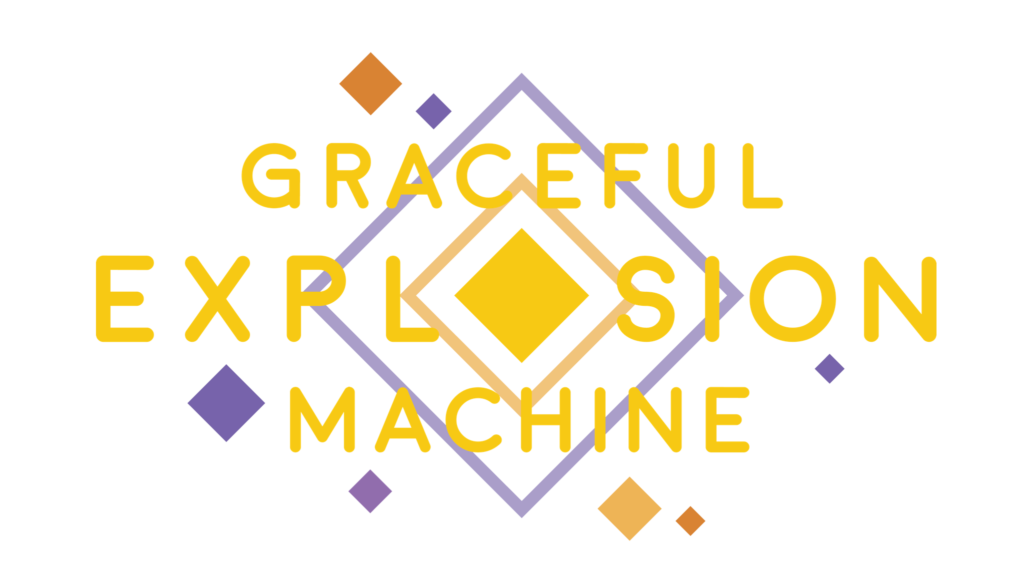
Graceful Explosion Machine.
Developer/Publisher: Vertex Pop || Overall: 6.5/10
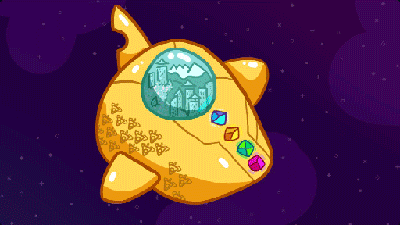
The title itself almost begs the comparison to Michael Bay’s Transformers movies, a point driven home by the fact that the protagonist is inside of a yellow vehicle. Like Bay’s movies, though, little is added to the genre with GEM.
It’s not that Graceful Explosion Machine is a bad game – far from it. It’s just that it doesn’t do anything to keep me coming back after two decades of playing games similar to it. GEM is a 2D ship shooter, much like the classic Defender, right down to needing to hit a button to turn around. The game’s premise being there was, like, this big ship, or something. There was a city in it, maybe? I’m not sure. There were some gems on it, and astro pops, I dunno. Anyway, these googly-eye’d robots spheres and oblong shapes came and blew it up. A ship popped out of the explosion, and the pilot was obviously distressed that the gems they had stolen from Bejeweled had been, in turn, stolen from them. So the ship pursued, intending to set fire to their planets. It’s open to interpretation, obviously, so I’ll just post a .gif of the intro sequence so you can decide. It gets the job done, but honestly, I would have been just as happy with no story, since the stills you see explain nothing aside that you’re killing things for a reason: sweet, buttery revenge on rye, dijon mustard and a side of coleslaw. I’ll take my revenge, hold all the other stuff. Thanks.
Alright, on to gameplay. The Defender comment was a hint here: it plays like Defender. The ship is moved in the cardinal directions, but it always faces left or right, a state that is changed with space (or left trigger if you’re using a controller, and I hope you are). Aside from the dedicated turn button, there is a dash/boost to dodge through enemies. If you’re in your 30’s and 40’s, you probably know what’s up here. It’s just as riveting as before, only by this point you’ve probably played PixelJunk Shooter and stuff. Kind of like when you have a succulent ribeye steak at any point before eating a New Castle burger.
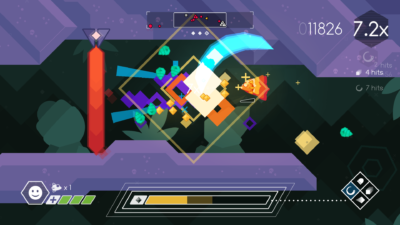 Now, for some reason this ship is unarmed until it picks up conspicuously laid out weapons in the tutorial, which is probably why these yellow guys got their shit ruined in the first place. First you get a pea shooter, which rapidly fires out blasts until it overheats, which is its only constraint. Second weapon, you get an “energy sword” which spins around twice on use, tearing into enemies and destroying enemy bullets. Next is a sniper beam, which is a very powerful beam that does a lot of damage and tears through enemy shields, but forces you to move slowly. The last is a missile barrage that can be directed out of your ship with a directional input before they race off to seek targets. With exception of the regular blaster, all weapons require weapon energy to fire. This is harvested from enemies on death via the yellow crystals they drop. The weapon energy meter doesn’t say what the max is, or how much each crystal is worth, nor is the energy required for attacks displayed anywhere, so it’s more of a fuel meter in that regard. Crystal/weapon power management seems to be the main bottleneck of player skill. Players need to swoop through slain enemies in order to get close enough to collect weapon power, which dictates how often you can use area of effect attacks. Gameplay quickly maxes out as an advanced game of chicken, blowing through enemies to collect weapon power to in turn massacre more enemies. The only real thing that mixes this up is how close enemies spawn, and if there’s an enemy that requires you to use the sniper cannon to kill quickly.
Now, for some reason this ship is unarmed until it picks up conspicuously laid out weapons in the tutorial, which is probably why these yellow guys got their shit ruined in the first place. First you get a pea shooter, which rapidly fires out blasts until it overheats, which is its only constraint. Second weapon, you get an “energy sword” which spins around twice on use, tearing into enemies and destroying enemy bullets. Next is a sniper beam, which is a very powerful beam that does a lot of damage and tears through enemy shields, but forces you to move slowly. The last is a missile barrage that can be directed out of your ship with a directional input before they race off to seek targets. With exception of the regular blaster, all weapons require weapon energy to fire. This is harvested from enemies on death via the yellow crystals they drop. The weapon energy meter doesn’t say what the max is, or how much each crystal is worth, nor is the energy required for attacks displayed anywhere, so it’s more of a fuel meter in that regard. Crystal/weapon power management seems to be the main bottleneck of player skill. Players need to swoop through slain enemies in order to get close enough to collect weapon power, which dictates how often you can use area of effect attacks. Gameplay quickly maxes out as an advanced game of chicken, blowing through enemies to collect weapon power to in turn massacre more enemies. The only real thing that mixes this up is how close enemies spawn, and if there’s an enemy that requires you to use the sniper cannon to kill quickly.
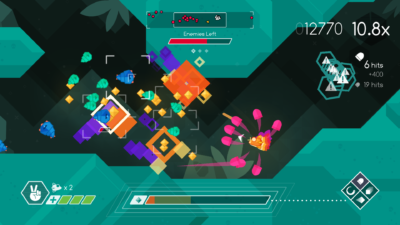 The game is divided into levels on four planets. A few open up for play, unlocking more as you complete them, culminating in a “warp” level to move on to the next planet. Each level has phases, which are this game’s checkpoint system; waves of enemies will spawn throughout an endlessly scrolling cave section as the player kills everything. Points are awarded for each kill, a multiplier in effect for consecutive kills and keeping a spree going. The ship is able to take three hits before dying, but each level has two continues, which can be utilized to restart from the beginning of the last phase that was started. The game isn’t exactly easy, but with tools like these, it’s not difficult either.
The game is divided into levels on four planets. A few open up for play, unlocking more as you complete them, culminating in a “warp” level to move on to the next planet. Each level has phases, which are this game’s checkpoint system; waves of enemies will spawn throughout an endlessly scrolling cave section as the player kills everything. Points are awarded for each kill, a multiplier in effect for consecutive kills and keeping a spree going. The ship is able to take three hits before dying, but each level has two continues, which can be utilized to restart from the beginning of the last phase that was started. The game isn’t exactly easy, but with tools like these, it’s not difficult either.
There’s plenty of different enemies, but most of the time, they either require a specific approach or a specific weapon, neither of which is much of a puzzle in the grand scheme of things. The problem is inherently with the focus of the game, which is entirely on score and leaderboards, rather than actual gameplay progression. This, coupled with spawns that don’t randomize, makes for a very stale “replayability” factor. Defender, way back in the day, got away with this by being a fixture in a public place with minimal mechanics and increasingly difficult and unforgiving gameplay, mostly to siphon quarters off kids. Well, that, and Defender is 36 years old. Graceful Explosion Machine has too many mechanics that it doesn’t dole out to keep the player interested, and thus have to use new enemies in lieu of new mechanics, powers or features to keep the player interested. Maybe it’s bad to expect more from games that go for $12.99 without a discount, but competition is stiff; there’s a myriad of games competing for your cash, and unless DeMar’s and Jarvis’ Defender is the model of what you consider an amazing experience, chances are you won’t be whisked away by this without a heaping spoonful of competitive spirit. Other games offer that competitive element too, obviously.
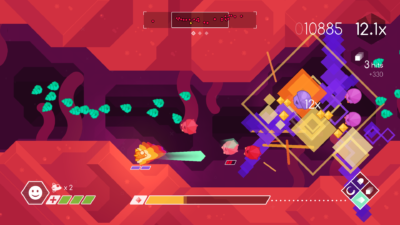 To its credit: the game runs well, and makes use of high refresh rate monitors. The music is benign, but not bad by any means. The controls on keyboard are serviceable, though I recommend controller. What’s more to say about a game that, mechanically, is solid even if there’s no carrot on the stick past score-whoring? There’s nothing particularly wrong with it, but it’s uninspiring, like a joke you’ve heard before, or a monologue on a topic you’re uninterested in.
To its credit: the game runs well, and makes use of high refresh rate monitors. The music is benign, but not bad by any means. The controls on keyboard are serviceable, though I recommend controller. What’s more to say about a game that, mechanically, is solid even if there’s no carrot on the stick past score-whoring? There’s nothing particularly wrong with it, but it’s uninspiring, like a joke you’ve heard before, or a monologue on a topic you’re uninterested in.
And, with that: I’d like to talk to you about our Lord, Gabe Newell. Our Father in Seattle, hallowed be your name. Your kingdom come, your will be done, on Earth as it is in heaven. Dot-gif us this day our daily gameplay, and forgive us our unpaid credit cards, as we…
*The droning of a long-winded joke, built on a foundation of memes, hits for 3d6 focus damage: 14 points*
*You roll d20 to save – a one*
*Quietly, you drift off; memories of your homeship and your ill-gotten Bejeweled gems haunt your dreams*
*You wake up, covered in a sticky substance. You’re not sure where you are or what you’ve been doing, but you have a feeling it was spent doing something slightly mediocre.*
That’s what the game is like. Some people might be interested, and may even find some enjoyment out of a Defender game with some extra bells and whistles, but the depth is shallow and the ride is short.











